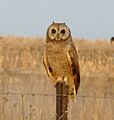This article is about amazing animals and plants that once lived in Europe but have sadly disappeared during the Holocene epoch. The Holocene is the time period we live in now, which started about 11,650 years ago. It covers Europe and its nearby islands, including big islands in the Mediterranean Sea like Sardinia and Corsica. Some parts of Georgia, Azerbaijan, and Armenia are also included, even though they are sometimes considered part of Asia.
Many of these creatures vanished because of things like hunting, losing their homes, or new animals arriving that competed with them. Sometimes, we don't know the exact date they disappeared, but we know they are gone forever.
Mammals: Animals with Fur! (Class Mammalia)
Mammals are warm-blooded animals that usually have fur or hair and feed their babies milk. Many large and small mammals have become extinct in Europe.
Giant Elephant Relatives (Order Proboscidea)
Elephants and Mammoths (Family Elephantidae)
| Common Name |
Scientific Name |
Where They Lived |
What Happened |
Pictures |
| Woolly mammoth |
Mammuthus primigenius |
Northern Eurasia and North America |
These huge, hairy elephants lived in cold places. The last ones in Europe disappeared around 9,650 BCE in the Southern Urals. |
 |
| Tilos dwarf elephant |
Palaeoloxodon tiliensis |
Tilos, Greece |
This small elephant lived on the Greek island of Tilos. It vanished between 3040 and 1840 BCE. |
 |
Rabbits and Pikas (Order Lagomorpha)
Rabbits and Hares (Family Leporidae)
| Common Name |
Scientific Name |
Where They Lived |
What Happened |
| Don hare |
Lepus timidus tanaiticus |
Russia |
This type of hare slowly disappeared as the mountain hare took its place, becoming extinct between 3050 and 550 BCE. |
| Common Name |
Scientific Name |
Where They Lived |
What Happened |
Pictures |
|
Ochotona transcaucasica |
Georgia and Azerbaijan |
This small, rabbit-like animal probably vanished early in the Holocene. |
|
| Sardinian pika |
Prolagus sardus |
Corsica and Sardinia |
This pika disappeared between 348 BCE and 283 CE. It was hunted by early humans, but likely died out because of new farming methods, new predators like dogs and cats, and diseases brought by other animals. |
 |
Locally Extinct Pikas
These pikas still exist elsewhere but are gone from Europe.
| Common Name |
Scientific Name |
Where They Lived |
What Happened |
Pictures |
| Steppe pika |
Ochotona pusilla |
Western Europe to Kazakhstan |
This pika disappeared from many parts of Europe by 1220 BCE. It doesn't like human activity, so it's a good sign of healthy steppe areas. |
 |
Rodents: Gnawing Animals (Order Rodentia)
Old World Rats and Mice (Family Muridae)
| Common Name |
Scientific Name |
Where They Lived |
What Happened |
Pictures |
|
Mus minotaurus |
Crete, Greece |
This mouse disappeared during the Bronze Age. It was outcompeted by the house mouse, which arrived on ships. |
|
| St. Kilda house mouse |
Mus musculus muralis |
St Kilda, Scotland |
This mouse lived alongside humans. It became extinct when all the people left the island in 1930. |
 |
Dormice (Family Gliridae)
| Common Name |
Scientific Name |
Where They Lived |
What Happened |
Pictures |
| Majorcan giant dormouse |
Hypnomys morpheus |
Gymnesian Islands, Spain |
This large dormouse vanished around 4840-4690 BCE, when humans first settled on the islands. It might have caught diseases from other animals brought by humans. |
 |
Carnivores: Meat Eaters (Order Carnivora)
| Common Name |
Scientific Name |
Where They Lived |
What Happened |
Pictures |
| Eurasian cave lion |
Panthera spelaea |
Northern Eurasia and Beringia |
These powerful lions disappeared from Europe around 9350 BCE. Some might have survived in mountain areas for a bit longer. |
 |
Locally Extinct Big Cats
These big cats still live elsewhere but are gone from Europe.
| Common Name |
Scientific Name |
Where They Lived |
What Happened |
Pictures |
| Cheetah |
Acinonyx jubatus |
Africa and western Asia to India |
Cheetahs lived in parts of Armenia until the 3rd millennium BCE, possibly even until the Middle Ages. They likely disappeared due to hunting. |
 |
| Lion |
Panthera leo |
Africa, western Asia, northern India, and southern Europe |
Lions once lived in southern Europe, including the Balkans. They disappeared from these areas by 370 CE, probably because of hunting and losing their homes as human populations grew. |
 |
| Tiger |
Panthera tigris |
Tropical and temperate Asia to the Black Sea |
Tigers were found in the Caucasus region and along the Caspian Sea until the 10th-12th centuries CE. The last ones in Azerbaijan were seen in 1966. They disappeared due to hunting and habitat loss. |
 |
| Common Name |
Scientific Name |
Where They Lived |
What Happened |
Pictures |
| Cave hyena |
Crocuta spelaea |
Europe and Central Asia |
These hyenas vanished from Europe around 9650 BCE. |
 |
| Common Name |
Scientific Name |
Where They Lived |
What Happened |
Pictures |
| Sicilian wolf |
Canis lupus cristaldii |
Sicily, Italy |
This wolf was hunted to extinction by farmers. The last confirmed one was killed in 1924. |
 |
| Sardinian dhole |
Cynotherium sardous |
Corsica and Sardinia |
This unique dog-like animal disappeared around 9910-9196 BCE, about the same time modern humans arrived on the islands. |
 |
Odd-toed Ungulates: Hoofed Animals (Order Perissodactyla)
Horses and Allies (Family Equidae)
| Common Name |
Scientific Name |
Where They Lived |
What Happened |
Pictures |
| Tarpan |
Equus ferus ferus |
Western Europe to western Siberia |
These wild horses were hunted for meat, hides, and to protect farms. The last one in the wild was killed in 1879, and the last one in a zoo died in 1887. |

 |
| Hydruntine |
Equus hemionus hydruntinus |
Southern Europe to northern Iran |
This wild ass lived in open grasslands, which became smaller and more spread out during the Holocene. It was also hunted by humans. The last ones disappeared around 1500-500 BCE. |
 |
Locally Extinct Wild Horses
These animals still exist elsewhere but are gone from Europe.
| Common Name |
Scientific Name |
Where They Lived |
What Happened |
Pictures |
| Turkmenian kulan |
Equus hemionus kulan |
Ukraine to Central Asia |
This wild ass was hunted out of Europe by the 18th or 19th century, especially with the use of firearms. They have been reintroduced to Ukraine since 1950. |
 |
| Common Name |
Scientific Name |
Where They Lived |
What Happened |
Pictures |
| Woolly rhinoceros |
Coelodonta antiquitatis |
Northern Eurasia |
These large, hairy rhinos vanished from Europe around 9450 BCE. |
 |
Even-toed Ungulates: Hoofed Animals (Order Artiodactyla)
True Deer (Family Cervidae)
| Common Name |
Scientific Name |
Where They Lived |
What Happened |
Pictures |
| Caucasian moose |
Alces alces caucasicus |
North Caucasus and the Black Sea coast |
This type of moose was hunted until it became extinct by the early 1900s. |
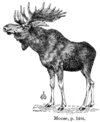 |
| Irish elk |
Megaloceros giganteus |
Europe and Southern Siberia |
Despite its name, this giant deer lived across Europe. The last ones disappeared around 5766-5643 BCE in Russia. |
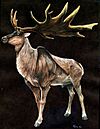 |
Cattle, Goats, and Antelopes (Family Bovidae)
| Common Name |
Scientific Name |
Where They Lived |
What Happened |
Pictures |
| Caucasian wisent |
Bison bonasus caucasicus |
Caucasus and Anatolia |
This type of European bison declined due to hunting and losing their forest homes. The last one was poached in 1927. |
 |
| Steppe bison |
Bison priscus |
Northern Eurasia and North America |
These ancient bison disappeared from Europe around 1130-1060 BCE. |
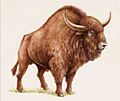 |
| Eurasian aurochs |
Bos primigenius primigenius |
Mid-latitude Eurasia |
These wild cattle were hunted and lost their grazing lands to farms. The very last aurochs died in Poland in 1627. |
 |
| Portuguese ibex |
Capra pyrenaica lusitanica |
Portuguese-Galician border |
This wild goat was hunted until it became extinct around 1890. |
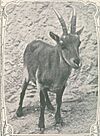 |
| Pyrenean ibex |
Capra pyrenaica pyrenaica |
Pyrenees and possibly the Cantabrian Mountains |
The last Pyrenean ibex, a female named Celia, died in 2000. Scientists tried to clone her, and a cloned baby was born in 2003, but it died minutes later. This means it's the only animal to become extinct twice! |
 |
| Balearic Islands cave goat |
Myotragus balearicus |
Gymnesian Islands, Spain |
This unique cave goat disappeared between 3969 and 2470 BCE. Its extinction was caused by the first human settlers on the islands. |
 |
Extinct in the Wild: Wisent
These animals only exist in zoos or special reserves, not truly wild.
| Common Name |
Scientific Name |
Where They Lived |
What Happened |
Pictures |
| Lowland wisent |
Bison bonasus bonasus |
Western Europe to southern Siberia |
The last wild population of this European bison was hunted during World War I. Thanks to zoo animals, they have been reintroduced to the wild in places like Poland and Belarus. |
 |
Locally Extinct Hoofed Animals
These animals still exist elsewhere but are gone from Europe.
| Common Name |
Scientific Name |
Where They Lived |
What Happened |
Pictures |
| Muskox |
Ovibos moschatus |
Northern Eurasia and North America |
Muskoxen disappeared from Europe around 7050 BCE. They have been reintroduced to Norway and Sweden. |
 |
Birds: Feathered Friends (Class Aves)
| Common Name |
Scientific Name |
Where They Lived |
What Happened |
Pictures |
| Great auk |
Pinguinus impennis |
Northern Atlantic and western Mediterranean Sea |
These flightless birds were hunted for their feathers, meat, and oil. The last pair in the eastern Atlantic was killed in Iceland in 1844. |
 |
Pelicans, Herons, and Ibises (Order Pelecaniformes)
Locally Extinct Ibises
This bird still exists elsewhere but is gone from Europe.
| Common Name |
Scientific Name |
Where They Lived |
What Happened |
Pictures |
| Northern bald ibis |
Geronticus eremita |
Mediterranean region |
This ibis disappeared from Europe before 1650 due to losing its home and being hunted. Projects are now reintroducing them to Austria and Spain. |
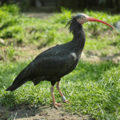 |
Crows and Relatives (Family Corvidae)
| Common Name |
Scientific Name |
Where They Lived |
What Happened |
Pictures |
| Pied raven |
Corvus corax varius morpha leucophaeus |
Faroe Islands |
This unique raven, with some white feathers, was last seen in 1902. |
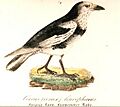 |
Reptiles: Scaly Creatures (Class Reptilia)
Squamates (Order Squamata)
Wall Lizards (Family Lacertidae)
| Common Name |
Scientific Name |
Where They Lived |
What Happened |
Pictures |
| Ratas Island lizard |
Podarcis lilfordi rodriquezi |
Ratas Island off Mahón, Spain |
This lizard was wiped out in 1935 when its island home was destroyed during harbor construction. |
 |
| Santo Stefano lizard |
Podarcis siculus sanctistephani |
Santo Stefano Island, Italy |
This lizard became extinct around 1965 due to disease and predators like snakes and feral cats brought to the island. |
|
Sturgeons and Paddlefishes (Order Acipenseriformes)
Locally Extinct Sturgeons
This fish still exists elsewhere but is gone from the Baltic region.
| Common Name |
Scientific Name |
Where They Lived |
What Happened |
Pictures |
| Atlantic sturgeon |
Acipenser oxyrinchus oxyrinchus |
Eastern coast of North America and the Baltic region |
The last known Atlantic sturgeon in the Baltic Sea was caught in 1996. They have been reintroduced to some rivers. |
 |
Salmon, Trout and Relatives (Order Salmoniformes)
Salmon, Trout and Relatives (Family Salmonidae)
| Common Name |
Scientific Name |
Where They Lived |
What Happened |
Pictures |
| True fera |
Coregonus fera |
Lake Geneva |
This fish disappeared in 1920. It became extinct because of too much pollution in the lake and too much fishing. |
 |
| Lake Constance whitefish |
Coregonus gutturosus |
Lake Constance |
This fish hasn't been seen since the early 1970s. Pollution in the lake killed all its eggs. |
 |
| Gravenche |
Coregonus hiemalis |
Lake Geneva |
This fish disappeared in the early 1900s, likely due to pollution and overfishing. |
 |
Extinct in the Wild: Beloribitsa
This fish only exists in captivity, not truly wild.
| Common Name |
Scientific Name |
Where They Lived |
What Happened |
Pictures |
| Beloribitsa |
Stenodus leucichthys |
Caspian Sea, Volga, Ural and Terek river areas |
The last wild beloribitsa was seen in the Ural River in the 1960s. Dams built on rivers destroyed its spawning grounds. It still lives in captivity and is sometimes released. |
 |
Insects (Class Insecta)
Butterflies and Moths (Order Lepidoptera)
Metalmark Butterflies (Family Riodinidae)
| Common Name |
Scientific Name |
Where They Lived |
What Happened |
Pictures |
| British large copper |
Lycaena dispar dispar |
England, United Kingdom |
This beautiful butterfly was last seen in 1864. |
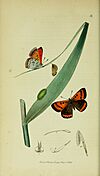 |
| British large blue |
Phengaris arion eutyphron |
Southern Britain |
This butterfly disappeared in 1979. A different type of large blue butterfly has since been brought from Sweden to replace it. |
 |
Cosmet Moths (Family Cosmopterigidae)
| Common Name |
Scientific Name |
Where They Lived |
What Happened |
Pictures |
| Manchester moth |
Euclemensia woodiella |
Kersal Moor, United Kingdom |
This moth was last seen in the 1820s. Only three museum specimens exist today. |
 |
Plants (Kingdom Plantae)
Primroses (Family Ericales)
Extinct in the Wild: Primrose
This plant only exists in cultivation, not truly wild.
| Scientific Name |
Where They Lived |
What Happened |
Pictures |
| Lysimachia minoricensis |
Barranc de Sa Vall, Minorca, Spain |
This plant disappeared from the wild between 1926 and 1950. We don't know exactly why. |
 |
Grasses (Family Poaceae)
Extinct in the Wild: Brome Grass
This plant only exists in cultivation, not truly wild.
| Common Name |
Scientific Name |
Where They Lived |
What Happened |
Pictures |
| Interrupted brome |
Bromus interruptus |
Wash to Severn estuaries, United Kingdom |
This grass disappeared from the wild in 1972, probably because of crop sprays and better seed cleaning. It was reintroduced in 2001. |
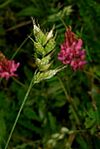 |
Images for kids
-
-
Fossil jawbones of a Tyrrhenian field rat.
-
Fossil jawbones of a Sardinian giant shrew.
-
A Balearic giant shrew compared to a Neomys.
-
-
-
-
-
A drawing of a hydruntine.
-
-
A North Atlantic right whale.
-
-
-
-
-
-
-
-
-
-
A Lake Constance whitefish.
-
-
-
-
Graecoanatolica macedonica.
-
See also























































